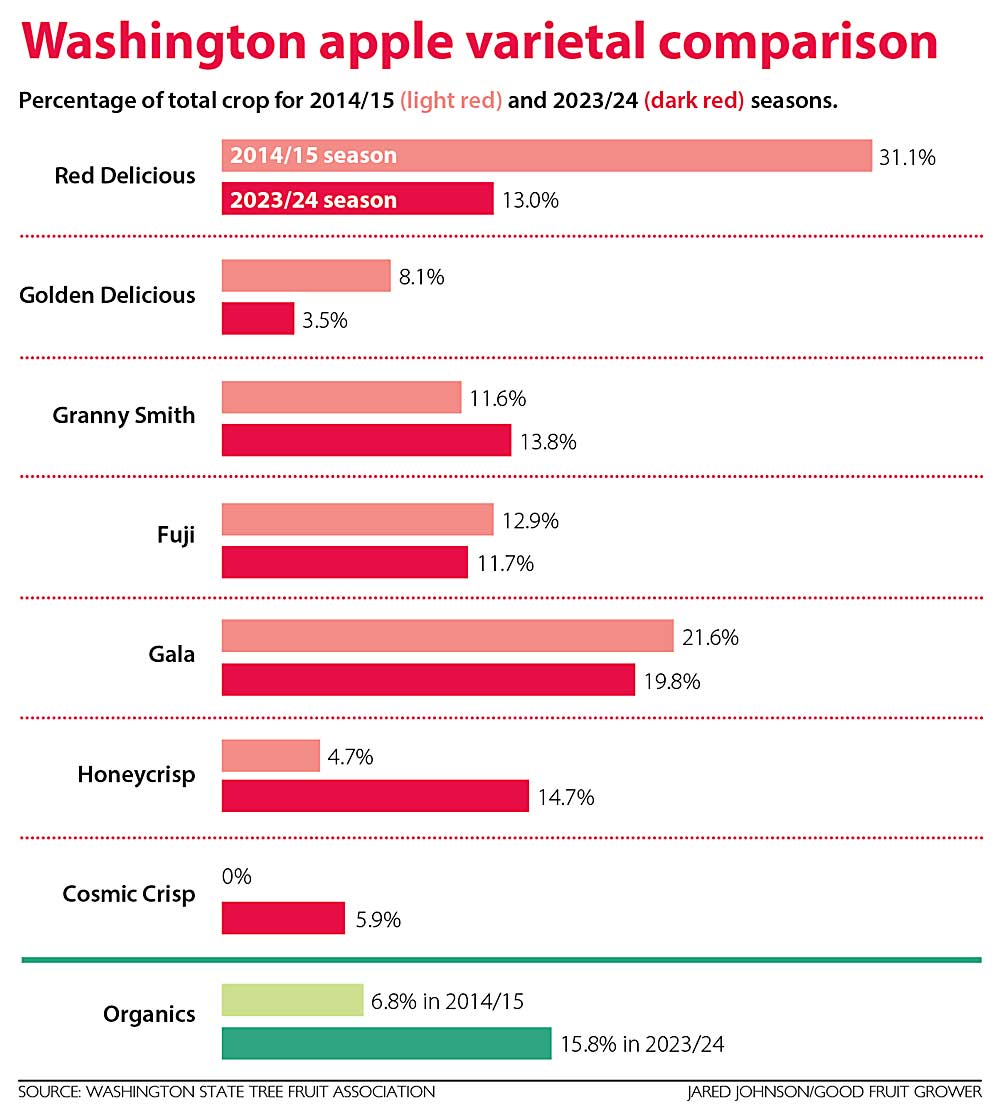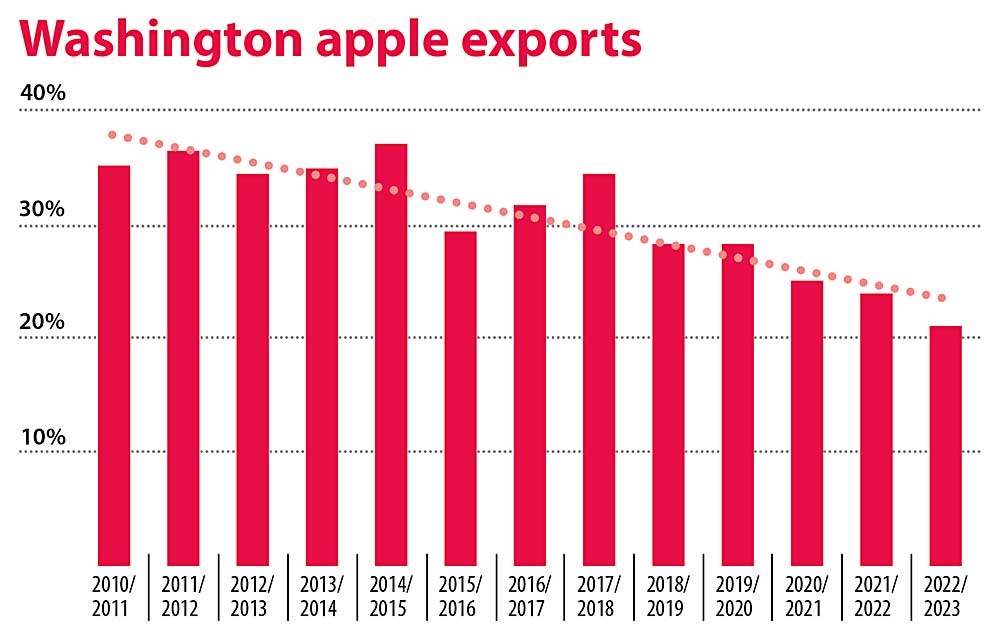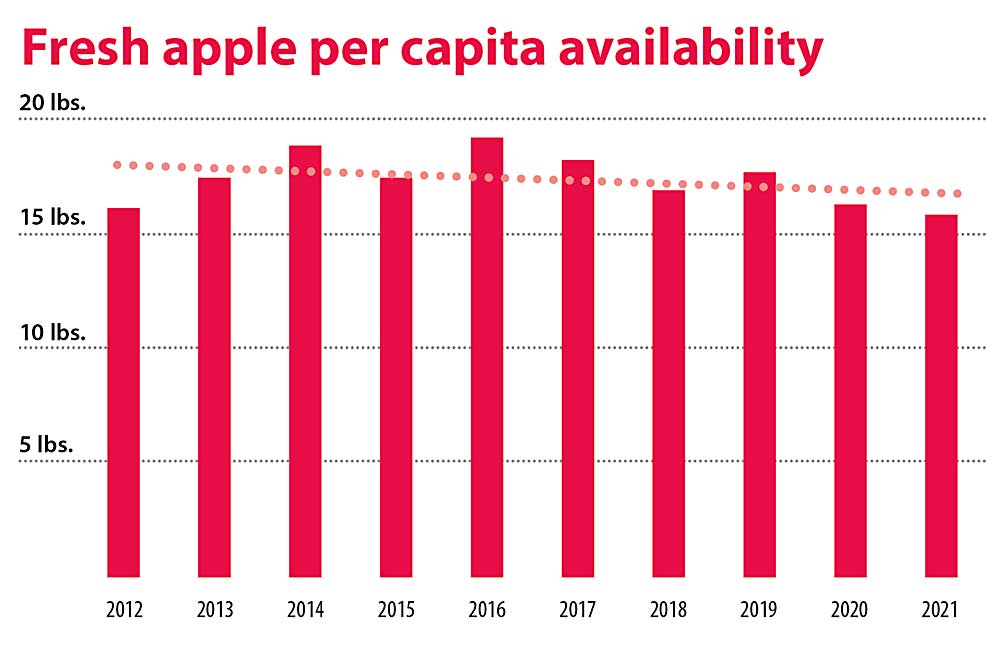
Just growing tasty, firm, new-variety apples isn’t enough any longer. Growers across the U.S. need to be activists, media experts and the stars in their own story.
Over the past decade, we’ve seen an explosion of wonderful, new, branded apple varieties such as Cosmic Crisp, Envy, Opal, Autumn Glory, SugarBee, SnapDragon, RubyFrost — and this is just the tip of the apple iceberg. All these new varieties look and taste good and have excellent texture. But do consumers know what they’re buying, and do they duplicate that purchase repeatedly?
Challenges abound in offshore exports: tariffs, increased competition, high freight rates and supply chain issues. Washington state, which represents over 90 percent of all U.S. exports, experienced the smallest export percentage in 20 years, with just 23.6 percent exported this past season. This decrease isn’t fully attributed to the challenges above; the move away from traditional cultivars to proprietary high-value apples plays a role. We’re growing less of what offshore markets can afford, which puts more emphasis on North American consumers. The days of a third of our crop being exported are over, because most offshore consumers simply can’t afford our apples.

Although the Washington Apple Commission is focused on international trade, we fully understand and agree with the development of exciting, better-tasting varieties targeting the North American consumer. High labor and input costs give growers no choice but to move away from mainstream varieties, like Red and Golden Delicious, for a chance to improve profitability with Honeycrisp, Cosmic Crisp and 40 other new varieties. But at the same time, declining per capita consumption necessitates exporting to maintain price equilibrium and grower profitability as our crop volumes outpace U.S. consumer demand.
The U.S. apple category has exploded in the past decade to meet domestic consumers’ needs for high quality, diverse flavor and improved texture. In Washington, we’ve seen mainstream varieties like Red Delicious decline from 31 percent of the crop in 2014–15 to 13 percent in 2023–24. Meanwhile, three categories have exploded: Honeycrisp increased from 4.7 to 14.7 percent, organic rose from 6.8 to 15.8 percent and the “other varieties” catchall category climbed from 4 to 9.4 percent. This category comprises 26 proprietary varieties (not including Cosmic Crisp), only seven of which come in excess of 300,000 bushels.
It’s difficult to find fault with the new varietal trend over the past decade — better apples should translate into improved per capita consumption, meet diverse consumer preferences and be profitable. Additionally, these new varieties can be more grower-friendly, increase per-acre volume and ultimately impact the grower’s bottom line. The new variety phenomenon doesn’t exist in a vacuum, as our brethren in most apple-producing states look to new varieties as well.
The challenge is that as the entire U.S. apple industry focuses on “getting better at what we do,” per capita consumption remains static or is decreasing.

As apple production increases, the need to export becomes even more necessary. A decade ago, Washington exported 35 percent of the crop to 60 countries, but the 2022–23 Washington apple crop saw just 23 percent exported. Is the decline an anomaly we can pin on the postpandemic freight costs and logistical challenges or, maybe, a trend?
The good news is that as an industry, in 2023–24 we’re probably in the best position we’ve ever experienced with excellent new varieties increasing in volume across the country.
The challenge facing apple growers across the U.S. is simply oversupply with declining international opportunities, coupled with static or declining per capita consumption.
New varieties are one part of the answer. Our greatest opportunity is to build U.S. per capita consumption as new varieties expand in volume. Consumers can be confused when immersed in the apple aisle of the produce department. So many apple varieties, all similar in color and shape. So many choices within the category, as well as many other competing produce items.
Apples need advocates to connect consumers to all the delicious options we have today. But in Washington, there isn’t enough support to reinstate a unified industry voice. The grower’s voice now lies in the hands of large, vertically integrated packers and sales groups that are innovating to communicate with consumers.
This is where the grower comes into play! Consumers are hungry for more information. Influencers such as Kaitlyn Thornton and Tyler Froberg have capitalized on social media to reach consumers and share insight into what it takes to produce, process and ship the agricultural commodities they represent.
With almost 350,000 TikTok followers, Thornton, a fourth-generation apple grower, posts videos that range from a funny farm family snippet to educating the consumer on labor costs in the orchard or discussing bloom time. Froberg, a fifth-generation farmer with a TikTok following of over 782,000, shares fun farm facts, featured produce, garden tips and more.
Social media platforms aren’t the only way a grower can get involved with telling their story. I think we can all agree, running a social media platform is no joke and almost becomes a second job! Growers such as Carlos Lopez, who owns and operates Lopez Orchards in partnership with his father, Antonio, has used alternative forms of media to tell his story. The Washington Apple Commission has partnered with Lopez several times for news articles and meet-your-grower interviews, and Lopez will be featured in a Washington apple episode in the upcoming 11th season of the television series Washington Grown.
Growers like Lopez should serve as inspiration to others. Tell your story, we need it! Your local commodity commission is the perfect resource, so please, reach out. These stories help build trust and confidence in the agricultural products you are proud to represent.
—by Todd Fryhover, Lindsey Huber and Jennie Strong
Todd Fryhover is the president of the Washington Apple Commission. He can be reached at: todd.fryhover@waapple.org. Lindsey Huber, international marketing manager, can be reached at: lindsey.huber@waapple.org, and international marketing specialist Jennie Strong can be reached at: jennie.strong@waapple.org. Visit the WAC online at: waapple.org or call 509-663-9600.






Leave A Comment